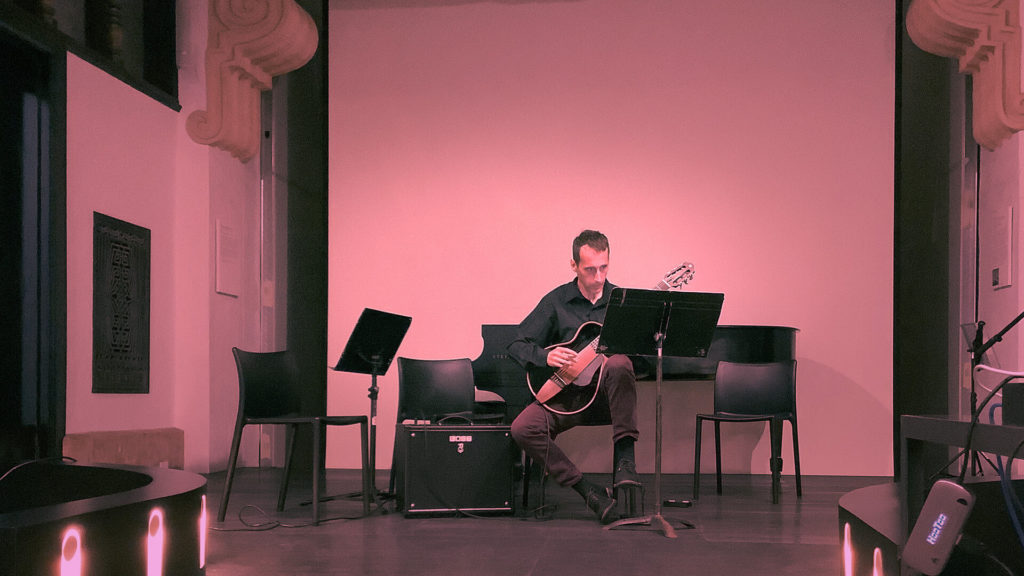
New and Experimental Music,
Art & Technolgy

New and Experimental Music,
Art & Technolgy
![Soundologia.com post [main category] [review,amernet quartet,] [New Music Miami ISCM Festival 2021] [00]](https://soundologia.com/wp-content/uploads/2021/10/soundologia.com_post_main-category_reviewamernet-quartet_New-Music-Miami-ISCM-Festival-2021-00.jpg)
In the past few weeks, Miami hosted several festivals and concerts featuring new and experimental music. Subtropics Festival, Miami Performance International Festival, Miami Light Project’s Here and Now, and New Music Miami ISCM Festival are just some of them. To note, this year, Miami celebrated the 25th anniversary of the Subtropics Festival (presented in episode 2 of the Soundologia podcast) and 24 years of the FIU School of Music’s New Music Miami ISCM Festival!
Spanned from February until the end of September, the New Music Miami ISCM Festival (NMMF) included nine concerts that introduced composers from around the world. It featured chamber music groups and acclaimed musicians including Mexico’s Duo Duplum, New York-based soprano and flutist Alice Teyssier, guitarists Colin McAllister and Jaime Márquez Diez-Canedo, the Misty Shore Duo, Calloway + Sudol Duo, the FIU’s Contemporary Chamber Ensemble, and the FIU NODUS Ensemble, and guest composers Ken Ueno, Zosha Di Castri, and Javier Alvarez.
On September 29, at the Wolfsonian in Miami Beach, the NMMF’s closing concert featured works by composers Zosha Di Castri, Alvin Singleton, Jacob Sudol, Mario Lavista, and Orlando Jacinto Garcia. Like all previous concerts, this one was live-streamed but also open to the public. Having all the performances available on Youtube, NMMF expanded its reach and offered a treat to wider contemporary music audiences to enjoy both concerts and pre-concert talks.
Likewise, before this closing event, the audience could hear the pre-concert talk given by an award-winning Canadian composer Zosha Di Castri, the Francis Goelet Assistant Professor of Music at Columbia University, and a 2021 Guggenheim Fellow. On this occasion, Di Castri presented one of the most significant works that brought her an international reputation – Long Is the Journey-Short Is the Memory. This piece, written for mixed choir and orchestra, was commissioned by BBC Radio 3 and performed on the First Night of the BBC Proms in 2019. It commemorates the anniversary of Apollo 11’s mission to land the first person on the Moon (almost 50 years to the day of the premiere) and draws inspiration from the recent Chinese Chang’e-4 Mission to the Moon, which included an experiment to grow plants in a sealed biosphere.
However, congruent with the concert’s chamber setting, the opening piece was Di Castri’s Dux for solo piano. Pianist Chen-Hui Jen, one of the most present and engaged performers of the modern piano repertoire in Miami, proved once again that she could handle all the technical requirements of the composition, confronting multiple rapid changes of rhythmical figures. The fluctuations of the dramaturgical flow in Dux happens between several contrasting segments in which the dominant energetic and effective rhythmic passages intertwine with occasional slow sections with broken chords. The central motif, which has the role of the dux (in the canonical counterpoint technique marked as an initial and leading melody), in whole and its parts, also intersects these slower segments or other arpeggiated structures that occur in different registers.
Time and After for string quartet and live electronics by Jacob Sudol was the following composition on the repertoire, performed by members of the Amernet Quartet (Misha Vitenson, Avi Nagin, Michael Klotz, and Jason Calloway) and the composer himself. Sudol is known for exploring the distant sound spaces of the frequency specter and layering different spectral lines, which he applies in this piece, too.
Processed through the electronic medium MAX/PSP software, the timbres of the strings instruments received additional distortions. Sudol eliminates any rhythmical or melodic figure emphasizing the sound interval frictions and dynamic nuances that bring the lack of movement in this twenty-minute long composition. Brilliantly balancing with these distorted sonorities, the Amernet Quartet was collaboratively immersed in the long-sustained lines exhibiting great control of their instruments and overall sound. The performance of Time and After is available on Bandcamp.
In contrast to the previous work, Madrigal by a Mexican composer Mario Lavista brought a playful rhythm of sixteenth notes right from the beginning. Lavista composed the music in 1985 for clarinet solo. In the first segment, voices exchange in different registers emulating a rapid and turbulent dialog in a theatrical manner conjuring a birds’ song. Although there is an echo of the Alberti bass that was particularly popular in the Classical era, the combination of downbeats and upbeats indicate the odd metric structures and different aesthetics. In the contrasting part, clarinetist Jesse Gilday delivered calm melodic movements with plenty of musical details, emphasizing occasional rhythmically interruptive segments. Gilday’s virtuosic performance successfully achieved Lavista’s challenge to expose the second voice achieved by the flageolet technique. These overtones ran simultaneously with the played notes in heterophony, these tunes brought us back to the time of madrigals in the Renaissance and early Baroque era.
The concert’s fourth composition was Argoru II, which American composer Alvin Singleton wrote for cello in 1970, provided a musical platform for the sheer virtuosic display. Originally derived from the Twi language, spoken in Ghana, the word argoru means “to play.” Jason Calloway’s exceptional performance showed the abounds of various technical requirements in this piece, such as the rapid changes of highly contrasted phrases. In addition, the piece’s rare short tonal fragments represent temporary resting places that take us back from modern sound to tonal landscapes. At the same time, primarily gestural technical movements in individual sections dominated by the sul ponticello technique imitate the pronunciation of linguistic and sentence structures. Similar to Madrigal by Mario Lavista, Singleton’s Argoru II evokes theatrical play with the elements of drama, including several characters that Calloway “portrayed” on the stage. For more about Alvin Singleton, check the interview with Singleton on Curtis.edu.
The last piece was timbres artificiales # 4 for the guitar solo by the NMMF’s artistic director and composer Orlando Jacinto Garcia, performed by Federico Bonacossa. The meditative decomposition of the chords exposed in the first segment resembled the musical flow that followed. Furthermore, the changes in tempo from slow-meditative to fast-pulsating, along with the elegant and soothing tone of Bonacossa’s guitar, evoked the nylon-stringed guitar playing style, which all connected the segments into the coherent music form. However, despite the inadequate acoustics of the space with the reverb that additionally extended the guitar’s tone, the effect was a particularly interesting drone/bordun that filled out the room with its reverberating sound.
The event concluded Zosha Di Castri’s String Quartet No. 1, performed by the Amernet String Quartet. The work was co-commissioned by the Americas Society (New York), CBC Music, and BISQC. After a distorted sound of an initial short and thunderous motif with tremulous tones, the expressive oases followed, reducing the tension of atonal harmonic language sound collisions. The Amernet quartet skillfully delivered all vibrating tonal frictions and counter-punctual entanglements with solid physical coordination and communication among the performers. String instruments also have a role of percussion instruments requiring from performers percussive playing techniques. This not only occurred in the cello part where Calloway vigorously but precisely twitched the strings creating rhythmic effects but in all other sections too when performers created microtonal melodies with the sudden pulls of the bow. The interpretation of Castri’s work was indeed a representative example of Amernet Quartet’s sonorous and technical qualities.
Even though Miami is one of the most attractive and multi-cultural tourist destinations in the U.S. with plenty of commercial art, it can also be incredibly proud of its new music and experimental art scene that continues to grow organically. We are looking forward to the next New Music Miami ISCM Festival 2022, which will start in January. We hope to have the founder of the festival, Orlando Garcia, in one of the next episodes of the Soundologia podcast to speak more about it.
